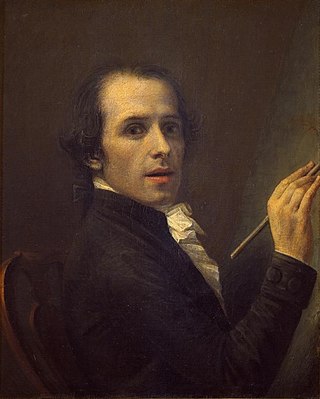
Antonio Canova was an Italian Neoclassical sculptor, famous for his marble sculptures. Often regarded as the greatest of the Neoclassical artists, his sculpture was inspired by the Baroque and the classical revival, and has been characterised as having avoided the melodramatics of the former, and the cold artificiality of the latter.

A supercomputer is a computer with a high level of performance as compared to a general-purpose computer. The performance of a supercomputer is commonly measured in floating-point operations per second (FLOPS) instead of million instructions per second (MIPS). Since 2017, there have existed supercomputers which can perform over 1017 FLOPS (a hundred quadrillion FLOPS, 100 petaFLOPS or 100 PFLOPS). For comparison, a desktop computer has performance in the range of hundreds of gigaFLOPS (1011) to tens of teraFLOPS (1013). Since November 2017, all of the world's fastest 500 supercomputers run on Linux-based operating systems. Additional research is being conducted in the United States, the European Union, Taiwan, Japan, and China to build faster, more powerful and technologically superior exascale supercomputers.
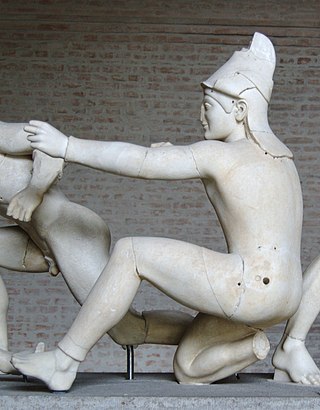
Marble has been the preferred material for stone monumental sculpture since ancient times, with several advantages over its more common geological "parent" limestone, in particular the ability to absorb light a small distance into the surface before refracting it in subsurface scattering. This gives an attractive soft appearance that is especially good for representing human skin, which can also be polished.

A stratocumulus cloud, occasionally called a cumulostratus, belongs to a genus-type of clouds characterized by large dark, rounded masses, usually in groups, lines, or waves, the individual elements being larger than those in altocumulus, and the whole being at a lower height, usually below 2,000 metres (6,600 ft). Weak convective currents create shallow cloud layers because of drier, stable air above preventing continued vertical development. Historically, in English, this type of cloud has been referred to as a twain cloud for being a combination of two types of clouds.

Ice sculpture is a form of sculpture that uses ice as the raw material. Sculptures from ice can be abstract or realistic and can be functional or purely decorative. Ice sculptures are generally associated with special or extravagant events because of their limited lifetime.
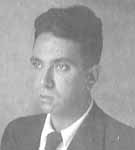
René Iché was a 20th-century French sculptor.

Thomas Schütte is a German contemporary artist. He sculpts, creates architectural designs, and draws. He lives and works in Düsseldorf.
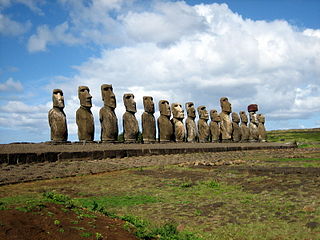
A stone sculpture is an object made of stone which has been shaped, usually by carving, or assembled to form a visually interesting three-dimensional shape. Stone is more durable than most alternative materials, making it especially important in architectural sculpture on the outside of buildings.

Carole A. Feuerman is an American sculptor and artist working in hyperrealism. Feuerman utilizes a variety of media including resin, marble, and bronze. She has been included in exhibitions at the Smithsonian Institution's National Portrait Gallery; and Palazzo Strozzi in Florence, Italy.
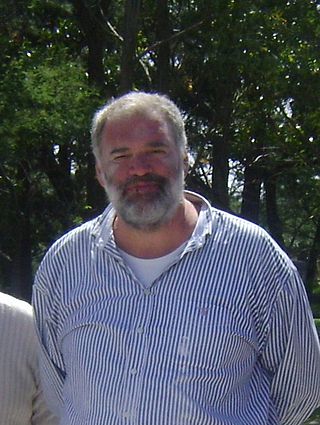
Pablo Atchugarry is a Uruguayan artist, best known for his abstract sculptural art. His works are included in many major collections, both private and public, and he has held more than one hundred solo and collective exhibitions worldwide.

Tanya Preminger, is an artist working in various media: environmental art, site-specific art, ephemeral art, sculpture, installation and photography. She is mostly known for her land art projects and large-scale stone sculptures.

Karen LaMonte is an American artist known for her life-size sculptures in ceramic, bronze, marble, and cast glass.
Glasstress is a recurring exhibition that brings together art by contemporary artists made with glass. Launched in 2009 as a collateral exhibition of the Venice Biennale of Arts by Adriano Berengo as a way of showcasing the works produced by Berengo Studio, it has since had editions take place in 2011, 2013, 2015, 2017, 2019, 2021 and 2022.
Eugen Ciucă was a Romanian-American artist known for his monumental sculptures, vivid paintings and drawings of delicate feminine figures. He spent the most successful years of his career in Italy, where he created many works inspired by the Divine Comedy and its author Dante Alighieri. Ciucă's art has been displayed in nearly 100 exhibitions across Europe and the United States.

Helidon Xhixha is a contemporary artist born in Durrës, Albania, in December 1970. Xhixha is known for his stainless steel sculptures, which is often fused with other mediums such as marble or brass.

Tomás Saraceno is an Argentine contemporary artist whose projects, consisting of floating sculptures, international collaborations, and interactive installations, propose and dialogue with forms of inhabiting and sensing the environment that have been suppressed in the Capitalocene era.
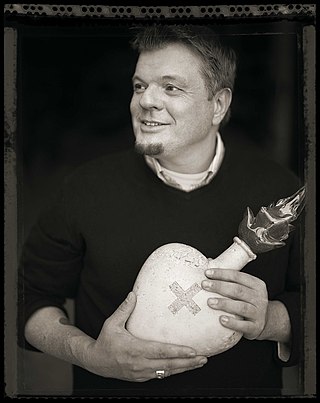
Tim Tate is an American artist and the co-founder of the Washington Glass School in the Greater Washington, DC capital area. The school was founded in 2001 and is now the second largest warm glass school in the United States. Tate was diagnosed as HIV positive in 1989 and was told that he had a year left to live. As a result, Tate decided to begin working with glass in order to leave a legacy behind. Over a decade ago, Tate began incorporating video and embedded electronics into his glass sculptures, thus becoming one of the first artists to migrate and integrate the relatively new form of video art into sculptural works. In 2019 he was selected to represent the United States at the sixth edition of the GLASSTRESS exhibition at the Venice Biennale.
Brick House is a 16-foot (4.9 m) tall bronze bust of a black woman by Simone Leigh, installed along New York City's High Line from 2019 to 2021. Another edition of the sculpture was acquired by the University of Pennsylvania and installed at the campus' main entrance in November 2020. This statue is the first sculpture in Simone Leigh’s Anatomy of Architecture series, which combines architectural forms from varied regions with elements of the human body.
Narine Arakelian is an Armenian interdisciplinary feminist artist; she works with Performance art, Installation art, Painting, Sculpture, Video art and Environmental art combining Fine Arts and Digital Technologies by using the custom designed Artificial Intelligence (A.I.). The artist creates artworks based on social, cultural and political issues focusing predominantly on social justice and gender identity.
Romolo Del Deo is an American sculptor, artist, and teacher. Best known for his bronze sculptures that put a “contemporary spin on the classical,” Del Deo’s art primarily explores two aesthetic themes: the debris that washes up on the shores of his native Provincetown, MA, and the archeological ruins of Italy. Del Deo is founder of the “Long Art” movement, and his work attends to the contemporary crisis surrounding sustainability and production while expressing, through touchstones in the mythological and classical, “the eternal.”















